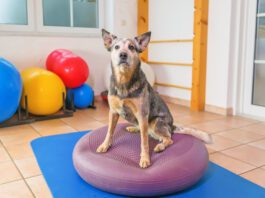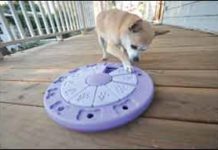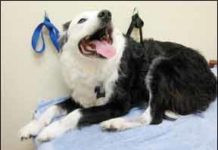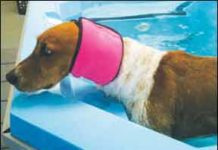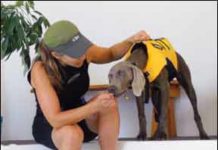Best Interactive Dog Toy and Puzzle Game – “Dog Twister”
Swedish dog owner Nina Ottosson first marketed some of her puzzles and games for dogs in Sweden in 1993; we first heard about them (and reviewed the original wood versions) in 2008. Since then, probably in a defensive response to a number of cheap plastic knockoffs of her designs, Ottosson has developed a line of high-quality plastic toys, though the original, beautiful wood models that are made in Sweden are still available.
Traditional Chinese Medical View on Dog Panting
From a Traditional Chinese Medicine (TCM) perspective, any medical condition is a symptom of an underlying disharmony within the body. This imbalance can be viewed through the yin and yang model, the base of TCM theory. Both exist within the body at all times. Yin represents the concepts of cooling, fluids, quietness, and passive behavior. Yang represents the concepts of heat, inflammation, outward energy, and aggressive behavior.
The Benefits of Apple Cider Vinegar to Dogs
People have been using vinegar for thousands of years, and while most of it goes into salads and condiments, vinegar can be used as a household cleanser, cosmetic aid, and health treatment. Many dog lovers add vinegar to their pets' food or apply it topically to their best friends. Advocates call vinegar, especially unpasteurized organic apple cider vinegar, a wonder food. Is vinegar really a health-improving supplement, a natural preservative, a nontoxic cleaning product, a disinfectant, a source of important nutrients, and an effective topical treatment for canine ailments?
Determining the Cause of Your Dog’s Panting
I’m awakened by the exhalation of my Border Collie’s warm breath on my face: heh-heh-heh. I slowly open one eye and focus on the nose just inches from my own. I may be anthropomorphizing, but I suspect he’s grinning. There it is again – a breathy heh-heh-heh. Wait a minute! Is he just panting or is he laughing at me? Given the way dogs are designed, panting is a very normal bodily function. Dogs don’t have sweat glands throughout their body to expel heat like humans do.
Canine Swim Caps?
Chloe, my eight-year-old Labrador Retriever, loves to swim. When we lived in New York, she spent almost every morning in streams and lakes, diving from high granite boulders in summer and breaking through ice in early winter. But when we moved to Montana, finding clear, open water for swimming was a challenge. Then we discovered the therapeutic pool at Apex Animal Hospital and signed up for recreational swims. Now every Tuesday Chloe swims laps while retrieving a tennis ball.
Canine Hydrotherapists
Two schools in the United States (the University of Tennessee and the Canine Rehabilitation Institute) offer certification to veterinarians, physical therapists, veterinary technicians, and physical therapy assistants in canine rehabilitation. Courses include canine anatomy and physiology; conditions and injuries commonly referred for rehabilitation; physical modalities and their application, contraindications, and equipment maintenance; therapeutic exercise; client education; sports medicine; and hydrotherapy.
The Benefits of Hydrotherapy for Your Dog
Hampton was a dependable flyball dog. The underwater treadmill increased his strength and stamina for the sport.üGracie the Dalmatian lives in Great Falls
How to Manage Multiple Barkers in the House
It's feeding time at the Miller household. All is calm until I pick up Scooter's bowl to carry it to the laundry room where the little Pomeranian can eat without harassment from the larger dogs. As I lift the bowl from the counter, Scooter erupts with high-pitched barking and spinning, and Lucy the Corgi joins in with her deeper-but-still-sufficiently irritating vocals. It's more of an annoying bit of ritual than a dangerous or disturbing one, but it's annoying just the same, and one that would be nice to extinguish.
Merial Runs Out of Immiticide for Heartworm Treatment
The supply of Immiticide (melarsomine dihydrochloride), the only drug approved to treat heartworm infections in dogs, has been low since December 2009, but now it’s completely gone. Merial confirmed that it was officially out of the drug on August 9, 2011. The current situation is due to a new and separate manufacturing challenge related to technical issues with the company who provides the finished product, according to a Merial spokesperson. Merial said the company is working hard to make the drug available again, but cannot speculate when that might happen.
A Study of Breed-Related Causes of Death in Dogs
A new 20-year retrospective study from the University of Georgia examined causes of death in dogs between 1984 and 2004. Researchers looked at records of 74,566 dogs from the Veterinary Medical Database, which includes data from 27 veterinary teaching hospitals. These results may be biased toward more severe, complicated, or unusual causes than the general dog population, but are fascinating nonetheless. The study grouped deaths by organ system and by disease category (“pathophysiological process”), and analyzed results based on age, breed, and average breed size. Eighty-two breeds with at least 100 representatives were included in breed-based analyses; mixed-breed dogs were considered as one group.
Bringing the Dog on Family Visits
If you are visiting family or friends, the key to a great vacation with your dog pal is to ask first! Be direct: Would it be convenient for me to bring my dog? Even if your family and friends love your dog as much as you do (or love you enough to understand that you are a package deal), there may be situations when it is just not suitable to bring your dog.
Sample Dog Park Rules
Park rules should be posted prominently near park entrances if they're not, ask about them prior to bringing your dog to the park, and make sure you are able and willing to comply. Here are some of the rules that you are likely to find...





